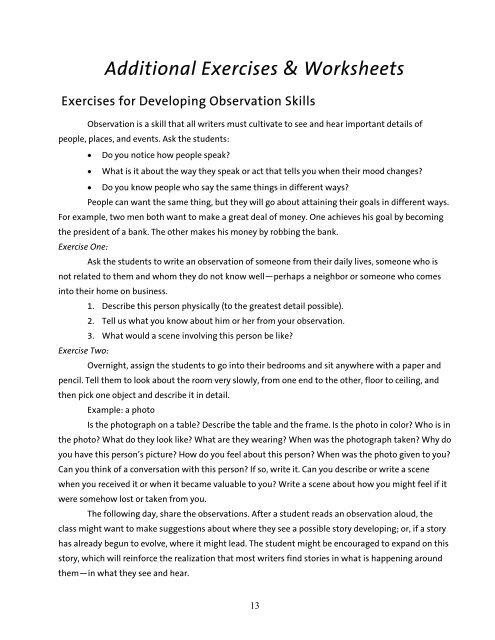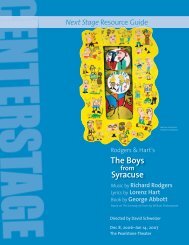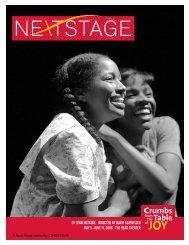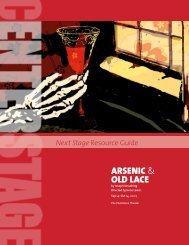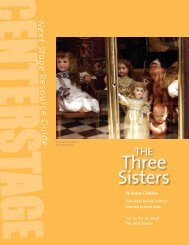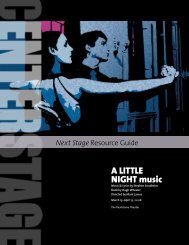Teaching Playwriting in Schools - Center Stage
Teaching Playwriting in Schools - Center Stage
Teaching Playwriting in Schools - Center Stage
You also want an ePaper? Increase the reach of your titles
YUMPU automatically turns print PDFs into web optimized ePapers that Google loves.
Additional Exercises & Worksheets<br />
Exercises for Develop<strong>in</strong>g Observation Skills<br />
Observation is a skill that all writers must cultivate to see and hear important details of<br />
people, places, and events. Ask the students:<br />
• Do you notice how people speak?<br />
• What is it about the way they speak or act that tells you when their mood changes?<br />
• Do you know people who say the same th<strong>in</strong>gs <strong>in</strong> different ways?<br />
People can want the same th<strong>in</strong>g, but they will go about atta<strong>in</strong><strong>in</strong>g their goals <strong>in</strong> different ways.<br />
For example, two men both want to make a great deal of money. One achieves his goal by becom<strong>in</strong>g<br />
the president of a bank. The other makes his money by robb<strong>in</strong>g the bank.<br />
Exercise One:<br />
Ask the students to write an observation of someone from their daily lives, someone who is<br />
not related to them and whom they do not know well—perhaps a neighbor or someone who comes<br />
<strong>in</strong>to their home on bus<strong>in</strong>ess.<br />
1. Describe this person physically (to the greatest detail possible).<br />
2. Tell us what you know about him or her from your observation.<br />
3. What would a scene <strong>in</strong>volv<strong>in</strong>g this person be like?<br />
Exercise Two:<br />
Overnight, assign the students to go <strong>in</strong>to their bedrooms and sit anywhere with a paper and<br />
pencil. Tell them to look about the room very slowly, from one end to the other, floor to ceil<strong>in</strong>g, and<br />
then pick one object and describe it <strong>in</strong> detail.<br />
Example: a photo<br />
Is the photograph on a table? Describe the table and the frame. Is the photo <strong>in</strong> color? Who is <strong>in</strong><br />
the photo? What do they look like? What are they wear<strong>in</strong>g? When was the photograph taken? Why do<br />
you have this person’s picture? How do you feel about this person? When was the photo given to you?<br />
Can you th<strong>in</strong>k of a conversation with this person? If so, write it. Can you describe or write a scene<br />
when you received it or when it became valuable to you? Write a scene about how you might feel if it<br />
were somehow lost or taken from you.<br />
The follow<strong>in</strong>g day, share the observations. After a student reads an observation aloud, the<br />
class might want to make suggestions about where they see a possible story develop<strong>in</strong>g; or, if a story<br />
has already begun to evolve, where it might lead. The student might be encouraged to expand on this<br />
story, which will re<strong>in</strong>force the realization that most writers f<strong>in</strong>d stories <strong>in</strong> what is happen<strong>in</strong>g around<br />
them—<strong>in</strong> what they see and hear.<br />
13


